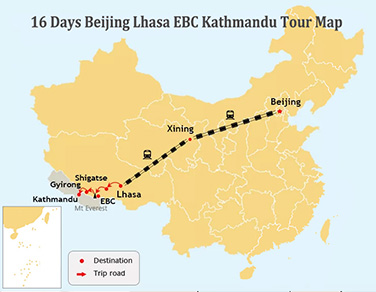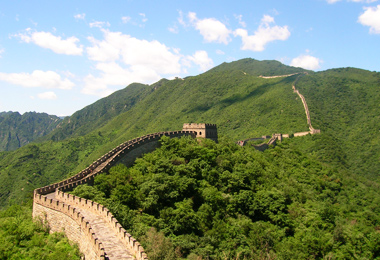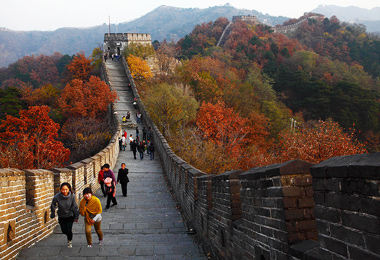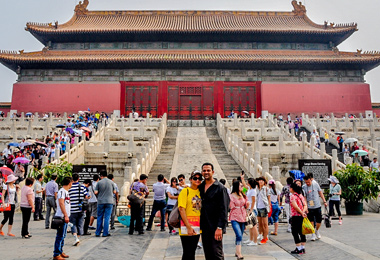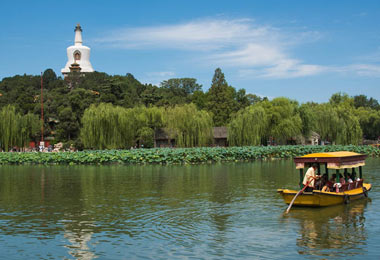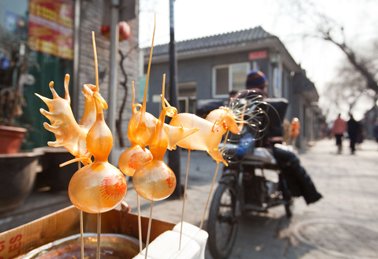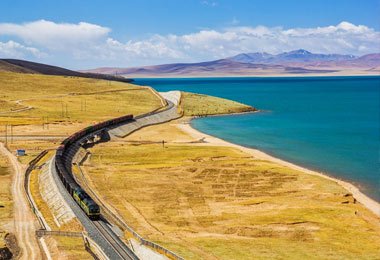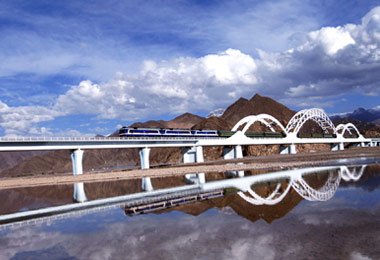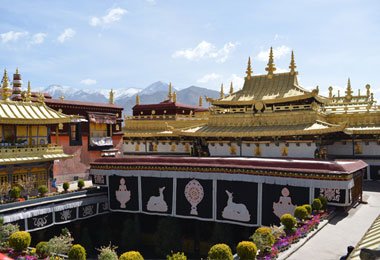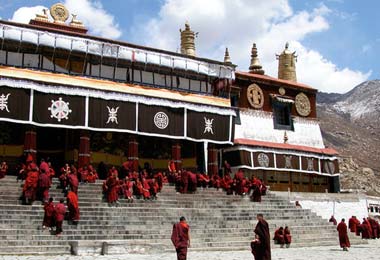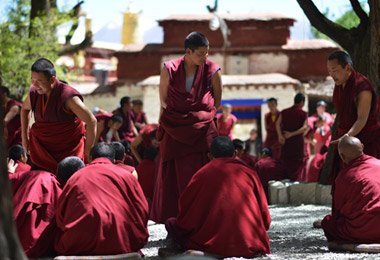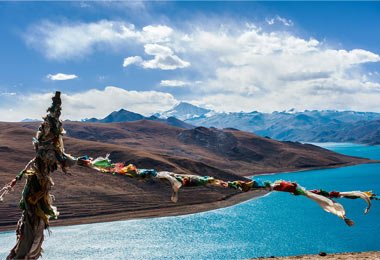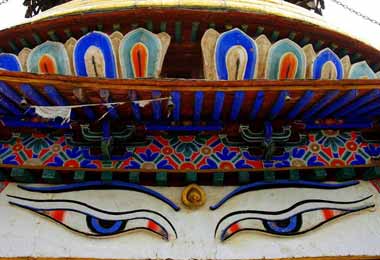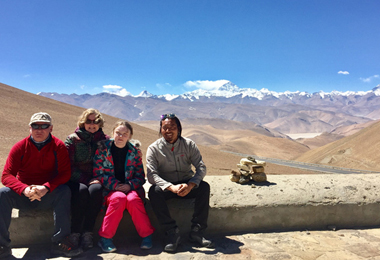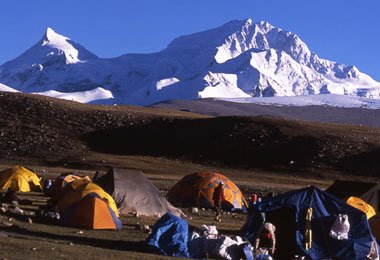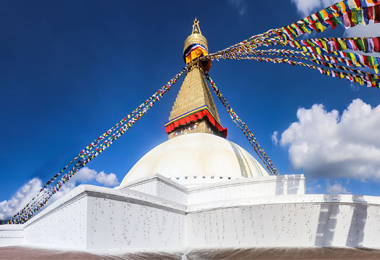
16-Day Beijing Lhasa EBC Kathmandu Tour
(BTN016) Beijing - By train - Lhasa - Gyantse - Shigastse - EBC - By overland - Kathmandu
-
Tour Type:
Escorted by private guide and vehicle; leave 365 days a year!
-
Trip Level:
Easy - suitable for all levels of fitness, family with kids and senior groups.
-
Trip Level Guide:
- Easy - suitable for all level of fitness, family with kids and senior groups.
- Moderate - suitable for ones with average level fitness, family with kids bigger than 12 yrs.
- Moderate to Strenous - suitable for ones physically fit; have experiences of high altitude trek.
- Strenuous: suitable for adventures and individual with physically fit and healthy.
-
Season:春
Spring夏
Summer秋
Autumn冬
Winter
Overview
This 16 days trip from Beijing to Lhasa by Tibet Train and extending to Kathmandu via Everest Base Camp offers you a rare chance to appreciate the Himalayans, from the snow land to the flourishing Nepal Kingdom at the foot of Himalayas. Before heading to Tibet, you will explore several highlighted attractions of Beijing, such as Great Wall, Forbidden City, Imperial Ancestral Temple, Beihai Park, etc.
Then, you will fly to Lhasa. Here, you will visit the Potala Palace, Jokhang Temple, Sera Monastery, and other notable scenic spots. Then, you will take an overland trip from Lhasa to Kathmandu along the highest national highway G318. En route, you will encounter the stunning Yamdrok Lake, world's highest Rongbuk Monastery, and the famous Everest Base Camp. Finally, you will arrive at Kathmandu after cross the Sino-Nepal border - Gyirong. In brief, this tour will be a life-time journey for you to visit Tibet and Nepal!
At a Glance
Day 1Arrive in Beijing
Day 2Beijing sightseeing - Mutianyu Great Wall
Day 3Beijing sightseeing - Forbidden City, Imperial Ancestral Temple, Beihai Park
Day 4Free Time to Tour Hutong - Nanluoguxiang and do Shopping
Day 5Train to Lhasa
Day 6Scenery View of Tibet Railway, Arrive in Lhasa
Day 7Arrive in Lhasa and Acclimate to the High Elevation of Lhasa
Day 8Lhasa Tour - Potala Palace, Jokhang Temple, Barkhor Street
Day 9Lhasa Tour - Drepung and Sera Monastery
Day 10Lhasa (3,650m) to Shigatse (3,900m) via Gyantse
Day 11Shigatse (3,900m) to EBC (5,200m) via Tingri
Day 12EBC to Gyirong Border (370km)
Day 13Gyirong to Kathmandu via Gyirong Border
Day 14Day Tour in Kathmandu: Durbar Square, Swayambhunath, Patan City
Day 15Day tour to Pashupatinath, Bodhnath and Bhaktapur City
Day 16Kathmandu Departure
Day to Day Itinerary
Day 1: Arrive in Beijing
Upon arrival in Beijing airport, our guide will be meeting you and get you transferred to your hotel in Beijing. The rest of the day is at leisure.
Stay overnight in Beijing.
Day 2: Beijing sightseeing - Mutianyu Great Wall
After breakfast, your guide will lead you to visit the majestic Mutianyu Great Wall. You will be taken on a group tour to the Great Wall, the most famous symbol of China and one of the world’s most remarkable architectural wonders. This section was first built during the Ming Dynasty (1368-1644 AD).
Stay overnight in Beijing.
Day 3: Beijing sightseeing - Forbidden City, Imperial Ancestral Temple, Beihai Park
Today, you will head to visit the magnificent Forbidden City which used to be the imperial palace of the Ming and Qing dynasties with a history of around 600 years. Then, you will move to the Imperial Ancestral Temple (also Taimiao of Beijing). Lying to the east of the imperial palace, the Forbidden City, the Imperial Ancestral Temple was a place where Chinese emperors stored their ancestors' tablets and worshipped them during festivals and ceremonies.
After that, you will visit Beihai Park. It is one of the oldest, largest and best-preserved ancient imperial gardens in China. With over 1,000 years' history, the park is not only a classic combination of the grandiosity of the northern gardens and the refinement of the southern gardens in China, but also a perfect integration of magnificent imperial palaces and solemn religious constructions.
Stay overnight in Beijing.
Day 4: Free Time to Tour Hutong - Nanluoguxiang and do Shopping
Hutong, which refers to traditional courtyard residence in narrow alleys in Beijing, is a great place where international tourists can learn the folk culture and old quarters of Beijing city.In the morning, tourists can are recommended to explore Nanluoguxiang yourself, one of the most famous Hutongs in Beijing.
With bustling main street, you will find a variety of cafes, kiosks selling different kinds of food and beverages and souvenir shops. A great way to tour Hutong is to enjoy the ride on a traditional rickshaw and rickshaw riders, most of whom can speak basic English, will take you to cover all the historical significance.
Stay overnight in Beijing.
Day 5: Train to Lhasa
The train departs from Beijing West Railway Station in the evening. It takes about 1 hour to check in as the train takes about 1000 passengers. Please be sure to arrive at the train station for 1 hour and a half before the train departure. Your Tibet Travel Permit will need to be checked when you check in.
Stay overnight on the Train.
Day 6: Scenery View of Tibet Railway, Arrive in Lhasa
It is quite a long journey that will take about 40 hours to Lhasa. You will first pass through two important provincial capital cities in northwest China, Lanzhou, and Xining. Xining is known as the beginning of Qinghai-Tibet Railway.
Travelling along the rail line, you could see the scenery of the countryside and city in northwest China. The last stop for today is Golmud, where you will arrive in late evening.
Stay overnight on the Train.
Day 7: Arrive in Lhasa and Acclimate to the High Elevation of Lhasa
You will witness the most beautiful scenery of Qinghai-Tibet Railway, spectacular land of snow, boundless desert, vast grassland, and grand ice mountains, beautiful lakes that will continually appear and strongly attract your heart.
You will arrive in Lhasa in the noon. Your tour guide will hold a board with your name at the exit of the train station to welcome you. Transfer to the reserved hotel by a private car.
Stay overnight in Lhasa.
Day 8: Lhasa Tour - Potala Palace, Jokhang Temple, Barkhor Street
Today's tour will first bring you to the Potala Palace which is the winter palace of the Dalai lama. It was put to use since the 7th Century by the 33rd great king of Tibet. The most valuable collections of Potala Palace are the gilded burial stupas of former Dalai Lamas and meditation Cave of the 33rd great king of Tibet.
Then after lunch, tourists head to Jokhang Temple which was founded by the 33rd great king of Tibet in the 7th century, in order to promote the Buddhist religion. Inside you can see the statue of Buddha Sakyamuni at the age of twelve, perhaps the only most venerated object in Tibetan Buddhism. Around the temple is Barkhor Street where you can do kora (a religious circle of a building or mountain) with pilgrims and locals, in the meantime, you can buy souvenirs.
Stay overnight in Lhasa.
Day 9: Lhasa Tour - Drepung and Sera Monastery
In the morning, you are going to visit Drepung Monastery which is one of the “great three” Gelug monasteries of Tibet, founded in 1416 by Jamyang choge, one of the Tsongkhapa’s main disciples. Ganden palace used to be Dalai lama’s palace in the Drepung before he moved to the Potala palace.
In the Afternoon, Tourists will visit Sera Monastery which is another one of the “great three” Gelug monasteries of Tibet, founded in 1419 by Jamchen Chojey, one of the Tsongkhapa’s main disciples. The hot attraction is the Monks debate at around 3 - 5 in the afternoon.
Stay overnight in Lhasa.
Day 10: Lhasa (3,650m) to Shigatse (3,900m) via Gyantse
In the morning, drive from Lhasa to Shigatse .On the way, drive over the Gampala Pass (4,790 m), and you will have a glimpse of Yamdrok-tso (4,400m) .The Lake is surrounded by many snow-capped mountains and in the distance you can have spectacular views of Holy Mount Nyenchen Khangsar (7,191m) the highest mountain near Lhasa.
Later, you will pass and enjoy the Karola Glacier on the roadside. At Manak Dam Lake, you can hang pray flag at Simila Mountain Pass; Then, you will arrive in Gyantse, historically Tibet's third largest city (after Lhasa and Shigatse). In Gyantse, you will visit the famous Pelkor Monastery and Gyantse Kumbum and enjoy the Far view of Gyangtse Fortress.
After one and a half driving, you will finally arrive at Shigatse, which is the second largest city in Tibet. In Shigatse, if time permits, you may have a chance to visit the traditional Barley Mill and view the landscape of Barley Field (in summer).
Stay overnight in Shigatse.
Day 11: Shigatse (3,900m) to EBC (5,200m) via Tingri
In the morning, your guide will bring you to visit the home of Panchan Lama - Tashilhunpo Monastery. After getting your Alien’s travel permit, you will drive to Lhatse, it is a small town where you can have lunch.
In the afternoon, the car will take you pass the Tsola Pass (4,600m), and Gyatsola Pass (5,248m). Later, we will enter Mt.Everest National Nature Reserve, you can enjoy the panorama of Himalaya at Gawula Pass (5,198m).Then we drive along the New zigzag road to Everest Base Camp(5200m). You can get closer to gaze at the Mt.Everest peak. The sunset of golden Everest peak if time and weather permits at the lodging area.
Stay overnight at Rongbuk monastery guest house.
Day 12: EBC to Gyirong Border (370km)
In the morning, you can appreciate the sunrise of Everest Peak if weather permits at the lodging area and then visit the Rongbuk Monastery - the unique world’s highest monastery. Later, we can visit the Everest Base Camp and take pictures of Mt.Everest at the closes distance in EBC.
After that, we can drive from EBC to Gyirong border. On the way, tourists can enjoy breathtaking vista of Mt.Shishapangma and the Peikutso Lake. After passing the Ghungtang Lhamo (5,236m), we will arrive in Gyirong in the late afternoon.
Stay overnight in Gyirong.
Day 13: Gyirong to Kathmandu via Gyirong Border
Tour Guide will assist the clients to exit China. And see clients off at Gyirong border. After you enter the Nepal territory, our Nepali guide will be expecting you on the Nepali-side border and transfer you to the hotel in Kathmandu. The distance between Kathmandu and Sino-Nepal border is around 130km. And the entire ride takes around 7-8 hours. On the way, you will enjoy cliff-side Nepali villages and terraced farmland and vibrant vegetation, etc.
Stay overnight in Kathmandu.
Day 14: Day Tour in Kathmandu: Durbar Square, Swayambhunath, Patan City
In the morning, we will the Kathmandu’s Durbar Square, which is one of three durbar (royal palace) squares in the Kathmandu Valley. It is the site of the Hanuman Dhoka Palace Complex, which was the royal Nepalese residence until the 19th century and when important ceremonies, such as the coronation of the Nepalese monarch, still take place today.
Then, we will tour Swayambhunath. It is one of the most recognizable symbols in Nepal and the painted eyes of Buddha watch all who ascend the worn stone steps. It is a World Heritage Site and one of the holiest Buddhist sites in Nepal, and is at the source of the Valley’s mythical beginning.
In the afternoon, the tour group will head to Patan City, which is 15 minutes driving from Kathmandu. Patan's central - Durbar Square, is absolutely packed with temples: It’s an architectural center point with a far greater concentration of temples per sq. meter than in Kathamandu or Bhaktapur. You may shop around and finally we will head back to Kathmandu.
Stay overnight in Kathmandu.
Day 15: Day tour to Pashupatinath, Bodhnath and Bhaktapur City
In the morning, we are about to tour Pashupatinath, the most important Hindu temple in Nepal, the old buildings on the site were destroyed by Moslem invaders in the 14th century, its stone linga smashed to dust, but it rose again behind their retreating backs. Succeeding monarchs reinstated the temple and the images.
Then you will explore the Bouddhanath, which is one of the largest stupas in South Asia, the focal point of Tibetan Buddhism in Nepal. The white mound looms thirty-six meters overhead. The stupa is located on the ancient trade route to Tibet, and Tibetan merchants rested and offered prayers here for many centuries.
The third attraction we will cover is Bhaktapur Durbar Square. It is a conglomeration of pagoda and shikhara style temples grouped around a fifty-five window palace of brick and wood. The square is one of the most charming architectural showpieces of the Valley as it highlights the ancient arts of Nepal.
Stay overnight in Kathmandu.
Day 16: Kathmandu Departure
You will be transferred to the International airport to connect onward flight.
Service Guide
Service Included:
- Tibet travel permit and all other necessary permits to Tibet;
- All entrance ticket fees for all tourist sites listed in the itinerary;
- Personal knowledgeable English-speaking Tibetan local tour guide;
- Personal comfortable, clean and safe vehicle with reliable Tibetan local driver; vehicle ranging from 4WD land cruiser to minibus depending on your group size;
- All lodging listed in the itinerary; it’s your decision about the accommodation class: luxury 5-star international hotel, comfortable 4-star hotel, economic 3-star hotel or budget hostel, guesthouse or tent. Please tell us your accommodation preference when submitting the enquiry; we will arrange the best-value hotels for you.
- Domestic flight/train tickets listed in the itinerary;
- All meals listed in the above itinerary;
- Tourist accident/casualty insurance;
- First aid kit;
Service Excluded:
- International flight to and out of China;
- Chinese visa (Note: we could help you with the Chinese visa application, like providing the invitation letter, presenting the hotel or domestic flight reservation copies, etc that you may need. )
- Domestic flight/train not listed in the itinerary. (We can provide you the domestic flight/train ticket booking service at the BEST discount price; please contact us our travel experts for the details.)
- Meals not specified in the itinerary; usually it costs about USD3-15 per person for one meal in TAR (Tibet Autonomous Region).
- Tips and gratitude to tour guide and driver;
- Personal expenses, like laundry, phone call, snacks, soft drinks (please do the best to avoid the alcoholic beverages during your Tibet trip), optional tour activities, etc.
Contact us for your dream trip now !
Enquire NowYou May Also Like
-
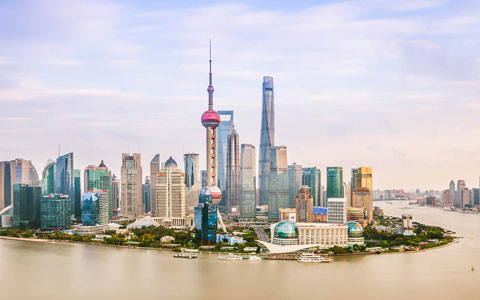 10-Day Shanghai Lhasa Kathmandu Tour
10-Day Shanghai Lhasa Kathmandu TourShanghai - By flight- Lhasa - By flight - Kathmandu
-
 12-Day Chengdu Lhasa and Namtso Kathmandu Tour
12-Day Chengdu Lhasa and Namtso Kathmandu TourChengdu - By train - Lhasa - Namtso - Lhasa - By flight - Kathmandu
-
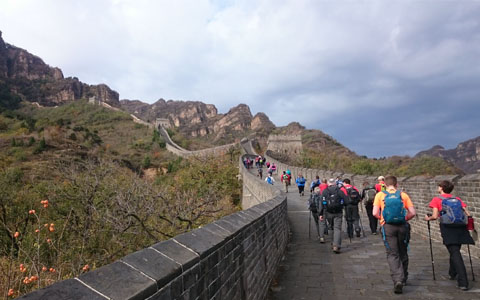 13-Day Beijing Lhasa Namtso Kathmandu Tour
13-Day Beijing Lhasa Namtso Kathmandu TourBeijing - By flight - Lhasa - Namtso - Lhasa - By flight - Kathmandu
-
 22 Days Beijing Xi'an Lhasa EBC Nepal Cultural Tour
22 Days Beijing Xi'an Lhasa EBC Nepal Cultural TourBeijing - By flight - Xi'an - By train - Lhasa - Gyangtse - Shigatse - EBC - By overland - Kathmandu - Pokhara - Chitwan - Lumbini - Kathmandu
Most Frequently Asked Questions from our Clients

It is a 14 days tour which takes you to visit the popular cities of China and Nepal. You will visit many highlighted attractions, such as Jinli Street, Wenshu Monastery, Chengdu Panda Breeding Center, Jokhang Temple, Potala Palace, Yamdro Lake, Everest Base Camp, Durbar Square, Swayambhunath, Patan City, etc. In brief, this tour is well-crafted combination Tibet Nepal trip from Hongkong that offers the best of Tibetan Highland including Mt. Everest and Historical and cultural hearts of Kathmandu.
Tibetan Travel Guru,Kham Sang
Get A Quotation of this Tour
Get Started - 16-Day Beijing Lhasa EBC Kathmandu Tour
You’re getting closer to your dream Tibet vacation! Fill out this form so our travel designers can start helping you plan a trip.
Privacy Policy: Your information is kept strictly confidential. Tibet Vista will never sell, trade, or give away your contact information to a third party.

.jpg)


